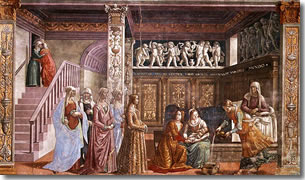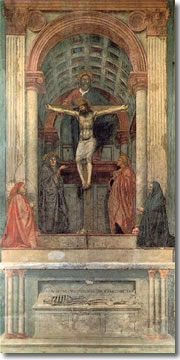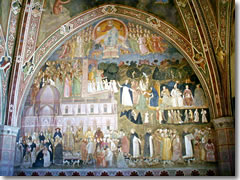
The church of Santa Maria Novella in Florence. (Photo by Georges Jansoone)Santa Maria Novella was begun in 1246 and completed in 1360, but the famous green-and-white marble facade—though it looks like a single, felicitous example of architecture—was actually built in two eras and two very different styles.
The facade's lower half was done in a Tuscan Romanesque style by Fra' Jacopo Talenti, but the upper half was added in 1456–70 by the great Renaissance architectural theorist Leon Battista Alberti, who managed to stamp it firmly with his exacting Neoclassical ideals while still managing to meld it seamlessly to the Romanesque bottom half.
Why am I going on about a facade that looks like a thousand other church facades out there? Because this was the original, the blueprint upon which those thousands of others were all modeled (it helped that Alberti coded his ideas and theories in widely-read architectural handbooks).
Note in particular Alberti's innovation of using large, curved triangular spaces decorated with oversized scrolls to bridge the gaps from the high roof of the central nave to the lower roofs of the side aisles.

Ghirlandaio frescoed a cycle on the Life of the Virgin Mary—including this Birth of the Virgin—in the Tornabuoni Chapel behind the main altar. The frescoes also read as a catalogue of daily Florentine life, dress, and customs in late 15th century Florence. Read more below.This cavernous Gothic interior was built to accommodate the masses who had come to hear the Word of God as delivered by the Dominicans.
The only problem was that the vast majority of the worshippers couldn't understand those all-important words, since the mass was entirely in Latin.
To make sure the less educated received at least some of the basic moral lessons and church teachings, the friars did what every good Italian church did back then: they filled the walls with the medieval version of a comic-book, translating Bible stories into cycles of frescoes that are some of the most important in all of Florence—a claim not to be taken lightly.

This is credited as the first painting in the history of art to use perfect linear mathematical perspective. It also cleverly continues the architecture of the into the painting itself, seeming to set the action in a virtual additional wing of the church. See the sidebar on the right for details.
(Notice I said that this was the first painting to use true perspective, not the first work of art. Masaccio was actually applying to the flat medium of fresco some of the insights Donatello had already made in sculpture when he pioneered a kind of single-point perspective in his schiacciato low-relief carvings, of which you can see some in the Bargello though the best examples are in the Siena cathedral's baptistery and museum.)
Near the Trinity is a 15th-century pulpit designed by Brunelleschi, most famous for being the spot from which Galileo was denounced for his heretical theory that the Earth revolved around the sun.
In the Cappella Maggiore (Main Chapel, a.k.a. Cappella Tornabuoni) behind the main altar and its bronze crucifix by Giambologna, Domenico Ghirlandaio created a fresco cycle supposedly depicting the Lives of the Virgin and St. John the Baptist, when in fact what we see is a dazzling illustration of what life was like and how people dressed during the golden days of Renaissance Florence.
It's sprinkled with snapshot vignettes of daily life, examples of all the top fashion styles of the day, and loads of local personalities, including a number of faces belonging to the Tornabuoni family, who commissioned the work.
In the Cappella Filippo Strozzi, to the right of this, are frescoes by Filippino Lippi (son of Filippo Lippi and a pupil of his father's famous student, Botticelli) after his return from Rome—which helps explain his painterly allusions to classical styles, which would begin to dominate the High Renaissance style.
Literature fans will note that this was the spot where the group of youngsters in Boccaccio's Decameron meet and decide to escape the city and wait out the Great Plague of 1348 at a country villa, where they swap stories to pass the time.
To the right of this chapel is the Cappella dei Bardi, covered with 14th-century frescoes; its lunette frescoes of the Madonna are believed to be by Cimabue (ca. 1285), Giotto's teacher.
To the left of the Cappella Maggiore is the Cappella Gondi and a 15th-century crucifix by Brunelleschi, his only work in wood. And to the extreme left is the Cappella Gaddi, with frescoes by Nardo di Cione (1357); the altarpiece is by Nardo's brother, Orcagna. The chapel awaits the return of Giotto's 13th-century Crucifix, now at the restorer.
Adjacent is the sacristy, worth a peek for the delicate glazed terra-cotta lavabo (sink where priests would wash their hands) by Giovanni della Robbia.
If you're not yet frescoed out, exit the church and turn right to visit the "Museum of Santa Maria Novella," which is composed of the frescoed cloisters and chapels of the attached convent.
The Chiostro Verde (Green Cloister) took its name from the prevalent green tinge of Paolo Uccello's 15th-century fresco cycle depicting scenes from the story of Noah and the Flood. (Ironically, these frescoes were themselves heavily damaged in the 1966 Arno flood.)

The Cappellone degli Spagnoli in the church of Santa Maria Novella. (Photo by Sailko)Opening off the cloisters is the Cappellone degli Spagnoli (Big Spanish Chapel), which got its name from the nostalgic Eleonora de Toledo, wife of Cosimo de' Medici, who permitted her fellow Spaniards to be buried here.
The chapel's captivating series of early Renaissance frescoes (recently restored) by Andrea de Bonaiuto glorify the history of the Dominican church.
In the fresco, the images of black-and-white spotted dogs represent Dominicans, who wore black robes over white shifts and were known as the "Hounds of the Lord," both for their zealous adherence to—and application of—doctrinal law as well as because it made a nifty Latin pun on the name of their order. (Domini means lord, canes means dogs, hence: Domini-canes. This, in the Middle Ages, passed for humor.)
Piazza S. Maria Novella (just south of train station)
tel. +39-055-219-257
www.chiesasantamarianovella.it
Mon–Thurs 9am–5:30pm, Fri 11am–5:30pm, Sat 9am–5pm, Sun 1-5pm (also Oct-Jun)
€5.00
With Firenze Card: Free
Bus: 6, 11, 22, C1, C2
Hop-on/hop-off: Barbetti (A), Curtatone (B)
Planning your day: You'll likely spend 30–40 minutes inside the church, maybe another 30–40 minutes in the museum. The ticket office closes 45 minutes early.
Take a guided tour of Chiesa di Santa Maria Novella with one of our partners:
You can attend mass: Sundays at 10:30am, noon (except July-Sept), and 6pm; Mon-Fri at 7:30am (except July-Sept) and 6pm; Sat at 7:30am (except July-Sept) and 6:30pm.
Santa Maria Novella is covered by the Firenze Card—free admission, no waiting in line. » more
Share this page
Search ReidsItaly.com
Piazza S. Maria Novella (just south of train station)
tel. +39-055-215-918
www.chiesasantamarianovella.it
Mon–Thurs 9am–5:30pm, Fri 11am–5:30pm, Sat 9am–5pm, Sun 1-5pm (open from noon Oct-Jun)
€5.00
Firenze Card: Yes
Bus: 6, 11, 22, C1, C2
Hop-on/hop-off: Barbetti (A), Curtatone (B)